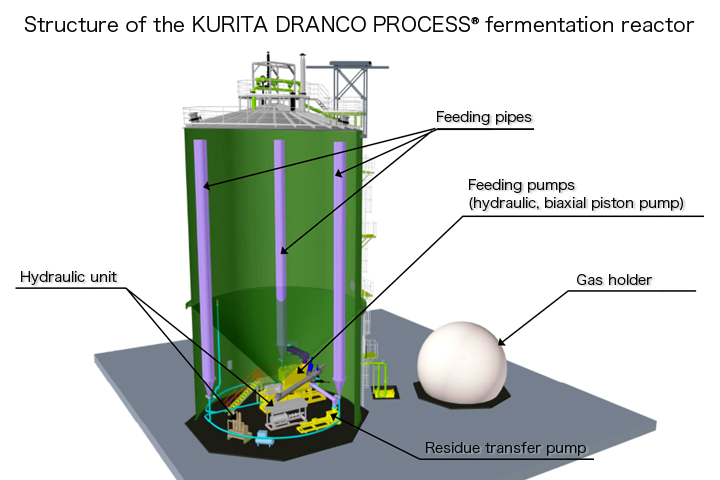2017
February 2, 2017
Japan's Largest Dry Anaerobic Digestion Reactor Accepted for the Promotion of the Use of Biomass Energy
KURITA DRANCO PROCESS® will promote the recycling of waste and the effective use of energy.
A joint project of Kurita Water Industries Ltd. (Head Office: Nakano-ku, Tokyo; President: MichiyaKadota; hereinafter "Kurita") and Fuji Clean Co., Ltd.(Head Office: Ayauta-gun, Kagawa; President: Kazuo Baba; hereinafter "Fuji Clean") has been accepted by the New Energy and Industrial Technology Development Organization (NEDO) as a project to be subsidized. Kurita and Fuji Clean has taken steps since April 2015 to participate in the "Demonstration of Self-Sustaining Regional Biomass Energy Systems/ Demonstration of Self-Sustaining Regional Systems/ Feasibility Studies," a project that NEDO has opened to participation. Kurita's dry methane fermentation technology, KURITA DRANCO PROCESS®, will be used at facilities that Fuji Clean will build to recover biogas as an energy source from waste through methane fermentation.
NEDO is taking the lead in the research, development and introduction of new energy and will subsidize the joint project to expand the use of biomass energy. Fuji Clean contributes to local communities through the treatment of waste using leading-edge technologies and aims to make the joint project a sustainable, economically feasible project that takes advantage of local characteristics. In the joint project, Kurita's proposal that it will segregate feedstock suitable for fermentation from mixed waste and waste paper from households and industrial waste, including organic waste sludge, paper and livestock excreta, using high-efficiency separation equipment, and will use dry methane fermentation has been accepted. In this way, Kurita will be able to recover biogas from a number of different types of waste (approximately 76 tons per day will be accepted) and use the gas as fuel and for electricity. Kurita will build facilities and will operate them on a trial basis so that operations begin in FY2018.
Kurita has conducted a variety of demonstration experiments related to dry methane fermentation and has promoted the use of biogas generated for energy from waste. Kurita's dry methane fermentation technology, KURITA DRANCO PROCESS®, uses a vertical fermentation reactor to reduce the footprint and does not discharge waste water due to the methane fermentation of low-water-content waste. Harnessing these experiences, technology, and expertise, Kurita will build Japan's largest single dry methane fermentation reactor (approximately 3,000 m3).
Facilitating the use of biomass energy is desirable because biomass energy, as renewable energy, helps reduce greenhouse gas emissions and achieve the optimum power source mix. The reduction of waste, improvements in the recycling rate, and the use of biomass energy are all expected to accelerate through an examination of the business model of the joint project.
As an advanced water and environmental management company, Kurita will seek to expand sales of dry methane fermentation technology to help reduce the customers' environmental burden and achieve a sustainable society.
Kurita has achieved the technology as a result of a project commissioned by NEDO.
<Supplementary material>
Features of KURITA DRANCO PROCESS®, dry methane fermentation technology
■Outline of facilities
- ・Material treated
- : approximately 76 tons per day; mainly general waste and industrial waste
- ・Equipment for pretreatment
- : high-efficiency separation equipment, crusher
- ・Equipment for generating biogas
- : vertical dry methane fermentation reactor (approx. 3,000 m3)
- ・Energy conversion equipment
- : two 370kW gas engines, boiler
- ・Schedule
-
: commencement of work (December 2016)
commencement of installation of machinery
and equipment (August 2017)
completion of work (March 2018)
Completion of commissioning work (planned to be in October 2018)
■Features of KURITA DRANCO PROCESS®, dry methane fermentation technology
- (i)Biogas can be recovered constantly from many kinds of biomass, including kitchen waste, animal and plant residues, paper, livestock manures, and rice straw and grasses, which have high fiber content.
The recovered biogas can be used for electricity and heat. - (ii)Feedstock that is not suitable for fermentation can be segregated using simple separation equipment.
- (iii)The vertical fermentation reactor will reduce the footprint. The structure of the reactor is simple, and there is no stirring equipment or humidifier. Thus maintenance is not necessary.
- (iv)Residues after fermentation have low water content, and no dewatering equipment or waste water treatment equipment is needed.


